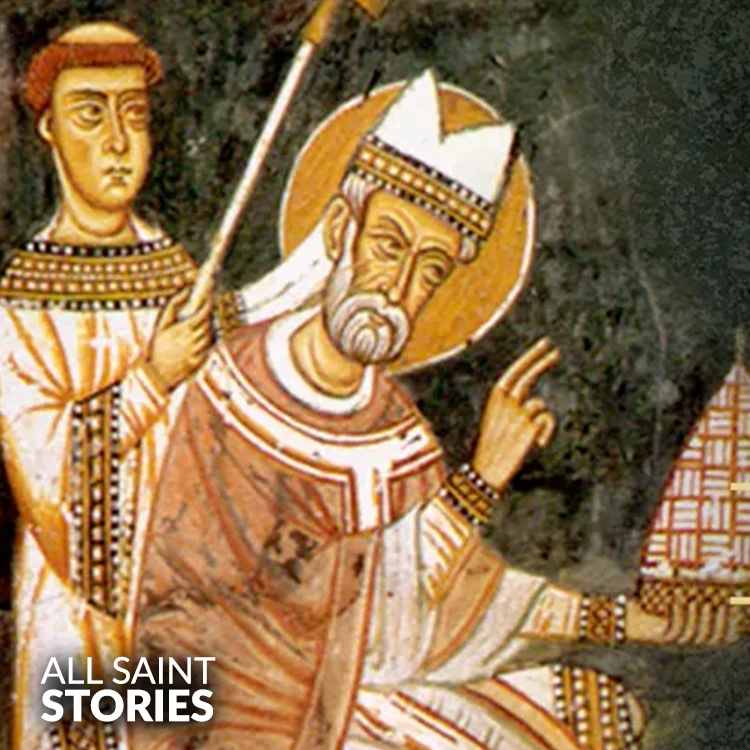St. Sylvester, Pope and servant of God, Pray for us to live with faith and devotion. Help us to follow Christ’s teachings And serve others with love and humility. Amen.
ST. SYLVESTER POPE
ST. SYLVESTER POPE

St. Sylvester I was pope from 314 to 335, during the reign of Constantine the Great. He guided the Church through a period of immense growth and helped establish Christianity as a major religion in the Roman Empire. His feast day is December 31.
St. Sylvester I served as the Bishop of Rome during one of the most transformative periods in the history of Christianity. Elected pope in the year 314, just a year after the Edict of Milan was issued by Emperor Constantine the Great, Sylvester’s pontificate coincided with the end of Roman persecution of Christians and the beginning of Christianity’s legitimization and eventual dominance within the Roman Empire. His reign lasted for 21 years, making him one of the longer-reigning popes of antiquity.
While Pope Sylvester himself did not attend the First Council of Nicaea in 325 AD, he played a crucial role by sending legates to represent him. This council was the first ecumenical gathering of bishops from across Christendom and was pivotal in defining core Christian doctrine, most notably the Nicene Creed, which countered the Arian heresy that denied the full divinity of Christ. Though not a theologian or statesman himself in the same vein as some of his successors, Sylvester’s leadership was nonetheless essential in guiding the Church during these foundational moments.
Sylvester’s pontificate also saw the construction of significant Christian basilicas under the patronage of Constantine. These included the original St. Peter’s Basilica, the Basilica of St. John Lateran (the cathedral of the pope), and the Basilica of the Holy Cross in Jerusalem. These monumental church buildings were not only architectural feats but also physical symbols of Christianity’s new prominence in Roman society. These acts set the stage for Christianity’s transformation from a persecuted sect into the religion of the empire.
Many legendary accounts surround Sylvester, especially from the centuries following his death. Among the most famous is the story that he baptized Emperor Constantine, who was said to have converted after being healed of leprosy by the pope. While this story has been largely debunked by modern historians and is considered part of later medieval legend rather than fact, it nonetheless reflects how influential Sylvester’s image became in Christian lore. These legends were also tied to the "Donation of Constantine," a forged Roman imperial decree that supposedly granted temporal power over the Western Roman Empire to the Pope. Although the document was proven to be a forgery during the Renaissance, it had a profound impact on the development of papal authority throughout the Middle Ages.
St. Sylvester died on December 31, 335, and was buried in the Church of San Silvestro in Capite in Rome. His feast day is celebrated on the same date, marking the end of the calendar year. In many European countries, especially in Germany, Austria, Switzerland, and parts of Italy, New Year’s Eve is still referred to as “Silvester” in his honor. The association with the New Year adds a unique cultural significance to his memory beyond ecclesiastical circles.
His canonization occurred in the early Church, before the formal process of canonization was established (known as “pre-congregation”). His sanctity was widely recognized due to his contributions to the Church’s early structure and his association with one of its most significant turning points—the transition from persecution to power.
Today, St. Sylvester is remembered not only as a historical figure but as a symbol of stability and leadership during a period of monumental change. His legacy continues to be celebrated in liturgy, culture, and tradition.
Video Not Found
The information on this website is compiled from various trusted sources. While we aim for accuracy, some details may be incomplete or contain discrepancies.
If you notice any errors or have additional information about this saint, please use the form on the left to share your suggestions. Your input helps us improve and maintain reliable content for everyone.
All submissions are reviewed carefully, and your personal details will remain confidential. Thank you for contributing to the accuracy and value of this resource.
Credits & Acknowledgments
- Anudina Visudhar (Malayalam) – Life of Saints for Everyday
by Msgr. Thomas Moothedan, M.A., D.D. - Saint Companions for Each Day
by A. J. M. Mausolfe & J. K. Mausolfe - US Catholic (Faith in Real Life) – Informational articles
- Wikipedia – General reference content and images
- Anastpaul.com – Saint images and reflections
- Pravachaka Sabdam (Malayalam) – Saint-related content and insights
We sincerely thank these authors and platforms for their valuable contributions. If we have unintentionally missed any attribution, please notify us, and we will make the correction promptly.
If you have any suggestion about ST. SYLVESTER POPE
Your suggestion will help improve the information about this saint. Your details will not be disclosed anywhere.
© 2025 Copyright @ www.allsaintstories.com



 English
English
 Italian
Italian
 French
French
 Spanish
Spanish
 Malayalam
Malayalam
 Russian
Russian
 Korean
Korean
 Sinhala
Sinhala
 Japanese
Japanese
 Arabic
Arabic
 Portuguese
Portuguese
 Bantu
Bantu
 Greek
Greek
 German
German
 Dutch
Dutch
 Filipino
Filipino